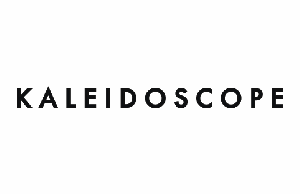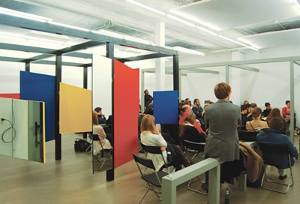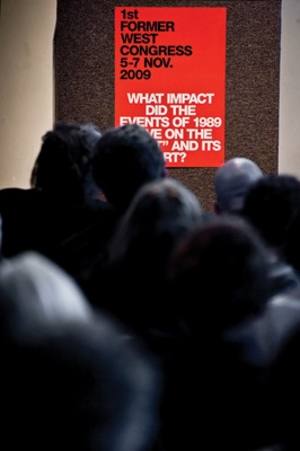L'edicola digitale delle riviste italiane di arte e cultura contemporanea
Kaleidoscope Anno 2 Numero 5 febbraio-marzo 2010
UTRECHT for example
Michele D'Aurizio

a contemporary magazine
Torbjørn Rødland
Hanne Mugaas
n. 22 autunno -inverno 2014
John Armleder
Andrea Bellini
n. 21 estate 2014
Voiceover: Under the skin
Shama Khanna
n. 20 inverno 2013-2014
Yang Fudong
Davide Quadrio e Noah Cowan
n. 19 autunno 2013
Massimiliano Gioni
Francesco Manacorda
n. 18 estate 2013
John Currin
Catherine Wood
n. 17 inverno 2012-2013



Where social and urban conditions generate a new sense of urgency, art and design institutions explore the meaning of words like “engagement” and “experimentation,” trying to beat a new path in the direction of genuine research.
The urban density of the Netherlands and, more generally, of the area known as the “Eurocore” (the expression is Rem Koolhaas’s and refers to the northwest of Germany and Benelux) is such that this region functions along lines similar to those of a metropolis. In this scenario, it is possible to think of Utrecht, as well as Amsterdam, Rotterdam and Eindhoven, as districts of a single metropolitan center. The cultural institutions of these cities have embraced this ambiguous situation and developed a plurality of approaches that are capable of operating locally, nationally and globally. In the case of Utrecht, the better-known Basis voor Actuele Kunst (BAK) and Casco: Office for Art, Design and Theory share the field today with ten or so other cultural centers, including Aorta, Expodium, Tumult and Vrede van Utrecht. Utrecht furthermore hosts a biennial of design, the Utrecht Manifest: Biennial for Social Design, and is home to the largest universities and art schools in the Netherlands. “With the different punctuations in their respective programs and practices, they together seem to me to contribute to forming a different cultural climate,” Binna Choi, the director of Casco, has said. Indeed in Utrecht, cultural productions based on inter- or trans-disciplinary approaches are testing the limits of various fields and postulating new roles for design, art and the applied arts. A sense of urgency is felt in the city with regard to the most pressing problems facing society. Utrecht’s cultural institutions are cultivating this sense, along with the sort of speculative thinking that translates those problems into the raw material for artistic and design activities and focuses attention on the unprecedented scenarios that these activities delineate. “Let us rethink what our next assignment could be,” says Guus Beumer, artistic director of Utrecht Manifest’s 2009 edition. In Utrecht, the discussions are animated and purposeful—including the one on the prospect that the Netherlands’ shared perspective and common action might one day give rise to a new cultural movement.
The legacy of furniture designer and architect Gerrit Rietveld, who built his masterpiece, the Schröder House, in Utrecht in 1924, and the activity of Pastoe, the furniture manufacturer that was founded in 1913 and is one of the emblems of Dutch design, bolster a vital tie with the modernist tradition and the movement’s social ambitions. Utrecht Manifest, for example, provides a platform for the kind of design that expresses its social engagement by opting for sustainability, quality and true innovation. “Design as a medium of the market and as merely a manifestation of an author has its limitations, since it operates mainly at the level of style,” writes Beumer in a reader published for the last edition of the biennial. “Functional design always disappoints since it never does what it suggests, and meta-design bores, since its validity as an instant and immediate form of communication loses its potency quickly.” Utrecht Manifest, on the contrary, is committed to “a design approach with a bit more urgency, a bit more consequence and a bit more scope!”?The third edition of the biennial, staged in the fall of 2009, proposed a reflection on the identity of social design. It was composed of four strands: an exhibition with examples of the art and design of the 20th century which traced the legacy of three legendary utopian texts—Ebenezer Howard’s Garden
Cities of To-morrow (1898), Siegfried Giedion’s Befreites Wohnen (1929) and Victor Papanek’s Design for the Real World: Human Ecology and Social Change (1971); a general survey of educational methods in the major Dutch design schools; an outline of accessible and low-cost products; and an exploration of the event’s own strategies of communication. ?Beumer is the first, however, to recognize that, “although powerful and a brilliant tool of communication, design is limited when not confronted with an external reality which is able to come up with an assignment or a productive context.” The biennial therefore has encouraged a direct intervention in the rapidly gentrifying district of Hoograven, inviting the architects Alfredo Brillembourg and Hubert Klumpner, who are active in the slums of Caracas under the name of Urban-Think Tank (U-TT), to mobilize the inhabitants and channel their energies into the conception and construction of structures for the community. By proposing alternatives to conventional urban development, U-TT has stimulated the Hoograven residents to bring their potential to bear on the struggle against the building boom. “Our experiences have taught us that interventions on an urban scale cannot be realized without a collective effort,” Brillembourg and Klumpner have declared, “an effort that is inherently collaborative, not hierarchical, and calls for mediation, negotiation and facilitation. In short, a role we believe architects can and must assume.”
In Utrecht, much of the population is under twenty-five. This demographic peculiarity makes it an effervescent place in which academics tend to focus on stimulating participation in the cultural life of the city. These efforts often translate into forms of organization that act within the local context, treating it as a case study. If Casco has promoted numerous projects that encourage reflection on Utrecht’s present, Choi says it does so “not to make a sort of package of local characteristics, specificity or identity.” Rather, she declares that “this need comes from the fact that one should engage from here and now, with one’s direct, physical surroundings, and it has more to do with the question of how to organize life in the so-called network society, where all relations seem to be a matter of exchanging abstract name values. That’s why our local engagement also differs from the evangelical approaches that have been prevailing in so-called community art.”?Since 1990, Casco’s activity has included, alongside numerous exhibitions, the publication of a house organ, Casco Issue (which has now reached its eleventh edition) and a crowded program of lectures, workshops and other opportunities for interaction with its public. “At Casco,” Choi continues, “the idea of creating a space of sharing and exchanging precedes the idea of setting an area of reception and contemplation. The spectatorship is surpassed by the idea of acting and thinking together of a scenario that a project presents.” ?When I met Binna Choi last November, she responded to my invitation to talk to me about the interaction between art, design and theory on the institution’s agenda by opening her notebook to a blank page and drawing a diagram. (In my view, the graphic schematization of her intents is already in itself a declaration of those same intents.) “The program could be understood by imagining a coordinate system that consists of one axis for the theoretical approach, one for art and one for design,” she explained. “Every project is located somewhere in these coordinates, without becoming identified with solely one axis.” In fact, the interdisciplinary approach guarantees immediacy, involvement and communicative effectiveness for Casco’s projects: “We not only seek to address the areas of art, design and theory independently, but to venture into their cross-fertilizations, shared concepts, critical discourses, and their connections to other fields.”?Our meeting took place in the apartment that Casco has rented for a year as its contribution to Utrecht Manifest. According to Choi, “In our time, when the division between the private and the public is either too wide or too blurred, the domestic site, or home, needs to be called on as the prime political site.” Thus the project, suggestively entitled User’s Manual: The Grand Domestic Revolution after Dolores Hayden’s 1982 seminal book, aims to revive the utopian dimension and—why not?—the very idea of revolution in cultural practices. “I once described The Grand Domestic Revolution as a movement,” Choi told me. “Whereas an action or a event has a temporal quality, a movement is more procedural, a means whereby a vision for a society is formed and materialized. I expect Casco itself to move forward and be recognized as a movement in the near future.”?Ambitious intentions are also harbored by Maria Hlavajova, who as director of the BAK has promoted a substantial project, Former West, which will keep the institution occupied until 2013. “The project was born out of a need to reconsider the artistic and cultural output of the ‘New World Order’ that the world embarked on with the year 1989,” declares Hlavajova. “We jump off from the fact that in the West, the year 1989 is not considered a crucial milestone; if recognized at all, then it is seen as something that brought really existing socialism to its end, and not as a patchwork of interrelated events that shifted the world on its pivot. We felt that a corresponding term to the widely-used ‘former East’ needed to be developed in order to express the gradual shifts in artistic, cultural, social, economic and political changes that happened in the so-called West after the end of the Cold War. So in fact, ‘former West’ is a constructed political category with which we first begin rearticulating the developments in art in the so-called West in the last two decades.”
“Beyond this engagement with our recent history,” continues Hlavajova, “the goal of Former West is to speculate about other possible futures, about the role of art and the main tool at its disposal—the imagination—in creating new social and political imageries, which could help us emancipate ourselves from the ideological vacuum that followed the ‘victory’ of the neoliberal form of democracy over the only serious competitive ideological system, that of communism. This is a complex undertaking that needs to be realized through re-reading the history of art, exhibitions, institutions, discourses, art activism, and the art market post-1989, and requires that we look closely at the relationship between the urgencies in society—such as issues of migration, global war, the return of religion, etc.—and artistic and intellectual production.”
Former West, which comprises the organization of solo and joint exhibitions, the publication of two bulletins and the staging of international congresses (the first of which was held in Utrecht from November 5 to 7, 2009), fully responds to the principles of “thinking, researching, producing, presenting and analyzing contemporary art” on which the BAK has founded its mission. “What interests us,” Hlavajova says, “is exploring the meaning and the place of art of, in and for our times, which we believe needs to be done through continuous moves in a number of directions, but mainly in acting through two vital relationships of art today: those of the alliance between art and theory and the link between art and the public, interconnected through a focus on particular urgencies.”?Network society has generated systems of governance in which cultural productions can intervene as antagonistic forms of organization.?Spectacular and populist culture “for the visitor” can give way to strategies of empowerment that generate in the public the awareness of being a political actor in society.?A first step in this direction could be what happens in Utrecht, for example.
MICHELE D'AURIZIO is Editorial Assistant of Kaleidoscope.


